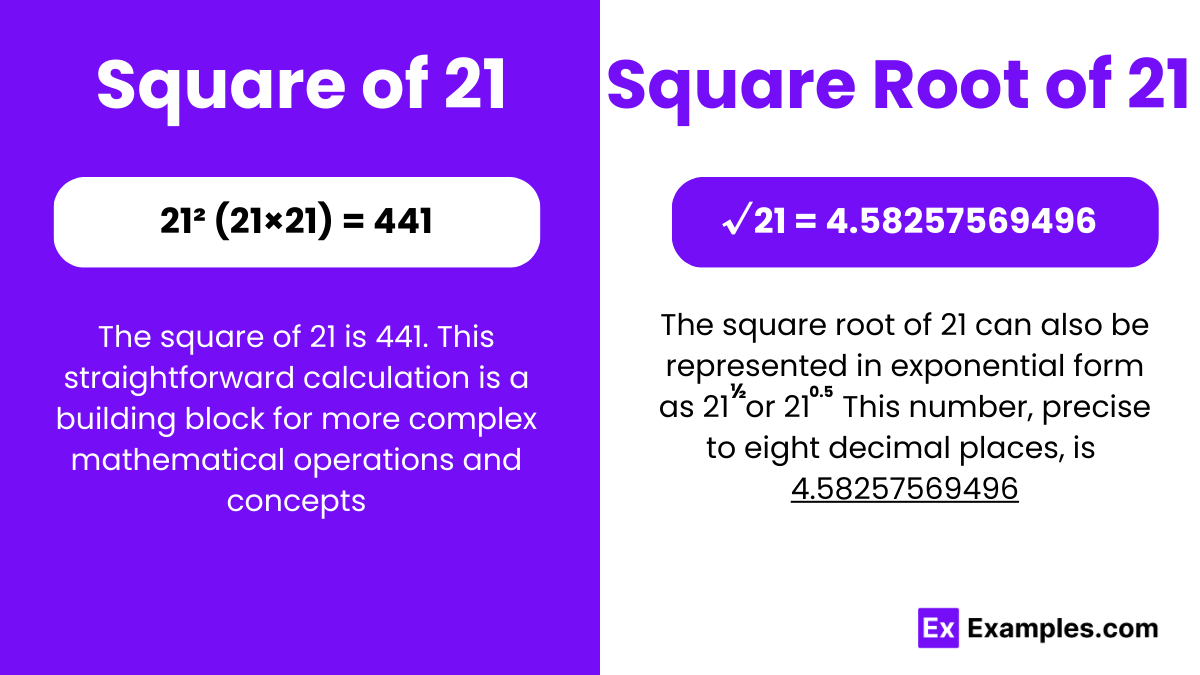What is the square of 21?
431
441
451
461

To calculate the square of 21, you multiply 21 by itself:
Therefore, the square Numbers of 21 is 441. This simple mathematical operation lays the groundwork for various advanced mathematical concepts and calculations, serving as a fundamental tool in arithmetic, algebra, geometry, and beyond.
The square roots of 21, denoted as √21, is an irrational number, meaning it cannot be expressed precisely as a fraction of two integers and has an infinite, non-repeating sequence of digits after the decimal point. The approximate value of √21 is 4.58257569496. This value is significant in mathematics and has various applications, including in geometry, algebra, and physics.
Square Root of √21:4.58257569496
Exponential Form:21^0.5
Radical Form:√21
A rational number is any number that can be expressed as a fraction a/b where a and b are integers, and b is not equal to zero. It includes integers, fractions, and finite or repeating decimals.
An irrational number is a number that cannot be expressed as a simple fraction. Irrational numbers have non-repeating, non-terminating decimal expansions.
This means it cannot be expressed as a fraction of two integers (no matter how large the numbers might be), and its decimal representation goes on infinitely without repeating. The proof of the irrationality of the square root of 21 follows similar lines to the proof of the irrationality of the square root of 2, demonstrating that it cannot be expressed as a fraction in simplest form, thus proving √21 must be irrational.
There are several methods to find the value of the square root of 21:
Prime Factorization Method: Decompose 21 into its prime factors, which are 3 and 7. Since both are distinct, we can write √21 = √(3×7). This simplifies to √3×√7.
Estimation Method: You can estimate the value of √21 by considering nearby perfect squares. Since 16 (4²) is less than 21 and 25 (5²) is greater than 21, we can estimate that √21 lies between 4 and 5.
Long Division Method: This method involves long division to approximate the square root. By using an iterative process, you can continually refine your approximation until reaching the desired level of accuracy.
Using a Calculator: Most calculators, including scientific calculators, have a square root function that allows you to directly compute the square root of a number. Simply input 21 and press the square root button to obtain the result.
These methods offer different approaches to finding the value of √21, each with its advantages depending on the context and level of precision required.

Step 1: Preparation
Write 21 as 21.00 00 00, grouping digits in pairs from the decimal point. For 21, it looks like “21”.
Step 2: Find the Largest Square
Identify the largest square smaller than or equal to 21, which is 16 (4²). Place 4 above the line as the first digit of the root.
Step 3: Subtract and Bring Down
Subtract 16 from 21 to get 5, then bring down the next pair of zeros to make it 500.
Step 4: Finding the Next Number
Subtract 425 from 500 to get a remainder of 75 and Bring down the next pair of zeros, making the new number 7500.
Step 5: Doubling the Root So Far
Double the current root (45) to get 90 and Look for a number that, when added to 900 and multiplied by itself, gives a result close to 7500.
Step 6: Refining the Guess
Adding 8 to 900 gives 908, and multiplying 908 by 8 gives 7264. Subtract 7264 from 7500 to get a remainder of 236 and Bring down another pair of zeros to continue the process with 23600.
Step 7: Finish at Desired Accuracy
Continue the process until reaching the desired level of accuracy. For the square root of 21, this method gives us about 4.582 as we extend the division.
As it cannot be expressed as the product of an integer multiplied by itself. In other words, there is no integer n such that n × n equals 21. This distinguishes 21 from perfect squares like 4, 9, and 16, which can be written as 2², 3², and 4² respectively. While 21 does have factors, such as 1, 3, 7, and 21, none of these factors are repeated, indicating that 21 is not a perfect square.
However, despite not being a perfect square, the number 21 still holds significance in mathematics and various other fields. It is a composite number, meaning it has multiple factors other than 1 and itself. In addition to its mathematical properties, 21 is notable in cultural contexts, often symbolizing coming of age or reaching a milestone.
You can use a calculator or iterative methods like Newton’s method.
The square root of 21 is an irrational number, as it cannot be simplified as the ratio of two integers.
It is an irrational number and therefore real.
Text prompt
Add Tone
10 Examples of Public speaking
20 Examples of Gas lighting
What is the square of 21?
431
441
451
461
Which of the following is closest to the square root of 21?
4.4
4.5
4.6
4.7
If x² = 21, what is x?
4.5
4.6
4.7
4.8
Simplify √21 to its decimal form.
4.58
4.59
4.60
4.61
What is (21)²?
431
441
451
461
Find the approximate value of √21 to two decimal places.
4.57
4.58
4.59
4.60
Which number is closest to 21 but not a perfect square?
22
24
26
28
What is 21 raised to the power of 0.5?
4.55
4.58
4.60
4.62
Calculate 21 × 21.
431
441
451
461
What is the square root of 21 rounded to the nearest integer?
5
6
7
8
Before you leave, take our quick quiz to enhance your learning!

